An orchestra in classical music is a large group of musicians all playing together. It’s made up of dozens of different instruments with some large symphony orchestras having more than 100 musicians!
In this post, we’re going to take a look at all the instruments that make up these different sections and what we call them.
What are the Sections of the Orchestra?

There are four sections of instruments in an orchestra. We call these different sections of instruments families.
The four families are:
- the string family
- the woodwind family
- the brass family
- the percussion family
Each instrument in the orchestra fits into one of these groups depending on the different characteristics they have in common.
For example, instruments in the string section unsurprisingly have strings!
And instruments in the brass family are, you guessed it, made out of brass.
String Section
There are four standard instruments in the string section (in order of highest to lowest pitch) are:
- Violin
- Viola
- Cello (violoncello)
- Double bass
Each of these instruments is made out of wood and are played using a bow which is pulled across the strings creating vibration and sound.
They vary quite a lot in size though, let’s take a look at the smallest of the string instruments: the violin.
The Violin

The highest pitched instrument in the string family is the violin.
It’s also the smallest and is played by holding it underneath the musician’s chin sitting on their shoulder.
In orchestral music, the violin will usually play the melody of a piece as its higher pitch can be heard over all the other instruments.
How many violins are there in an orchestra?
In a typical orchestra, there are two sections of violins, around 16 in the first section and 16 in the second section.
The Viola

Often confused with a violin, the viola is a slightly larger string instrument that’s played in the same way as the violin.
The viola is one of the only instrument that uses the alto clef to read music.
Due to its warm tone violas will usually play the harmony in support of the violin’s melody.
How many violas are there in an orchestra?
There are typically 12 violas in an orchestra.
The Cello (violoncello)

Next, we have the cello also called the violoncello.
It’s a lot larger than the viola and violin and is played with it resting between the musician’s legs with a spike or endpin supporting it on the ground.
It plays notes an octave lower than the viola and an octave above the double bass (which we’ll look at next).
How many cellos are there in an orchestra?
There are typically 8 – 12 cellos in an orchestra.
The Double Bass

The double bass is the largest standard orchestral string instrument.
It’s sometimes called the upright bass, contrabass or string bass.
It’s the lowest pitch string instrument sounding an octave lower than the cello.
Because double basses are so big (taller than most musicians) it’s usually played standing up or sitting on a stool.
The double bass is one of my favourite instruments, I studied it at music college 🙂
How many doubles basses are there in an orchestra?
There are are usually 6 – 8 basses in an orchestra.
Brass Section
The brass section is made up of instruments which are essentially long pipes that musicians blow air into.
They press their mouths to the mouthpiece and blow air down it by buzzing their lips. Just like blowing a ‘raspberry’!
The four instruments in a standard orchestra brass section (in order of highest to lowest pitch) are:
- Trumpet
- French horn
- Trombone
- Tuba
The Trumpet

The trumpet is the highest sounding of the brass instruments and has been around for a long time. As long ago as 1500 BC!
A trumpet has three valves that the player can press to extend or shorten the distance that the air has to travel. This changes the pitch of the note.
How many trumpets are there in an orchestra?
A typical orchestra will have around four trumpets.
The Horn (French Horn)
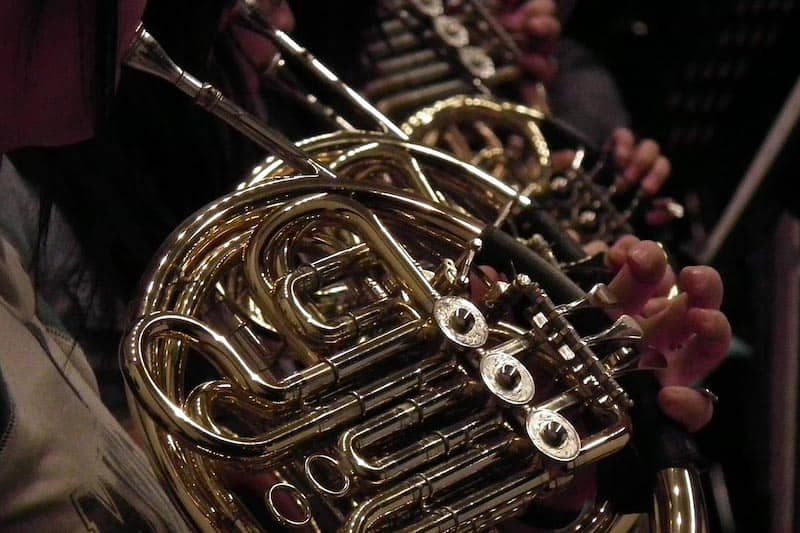
The Horn (also just called the French Horn) is another type of brass instrument that is made out of narrow brass tubing.
The horn is different from other brass instruments as it’s played with the left hand.
A horn player will hold the horn with their right hand inside the bell and press the valves with their left hand.
How many horns are there in an orchestra?
There can be anywhere from 2 – 8 horns (french horns) in an orchestra.
The Trombone
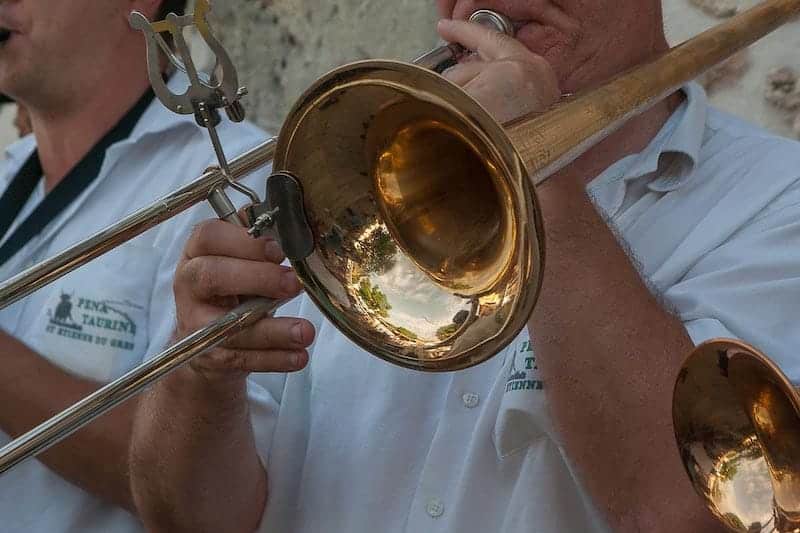
The trombone is a very unique brass instrument.
Rather than using valves to change the pitch of notes, it uses a slide with seven different positions.
When the slide is fully extended it means the air has to travel further and so produces a lower pitch note and vice versa.
How many trombones are there in an orchestra?
There are usually three trombones in an orchestra.
The Tuba
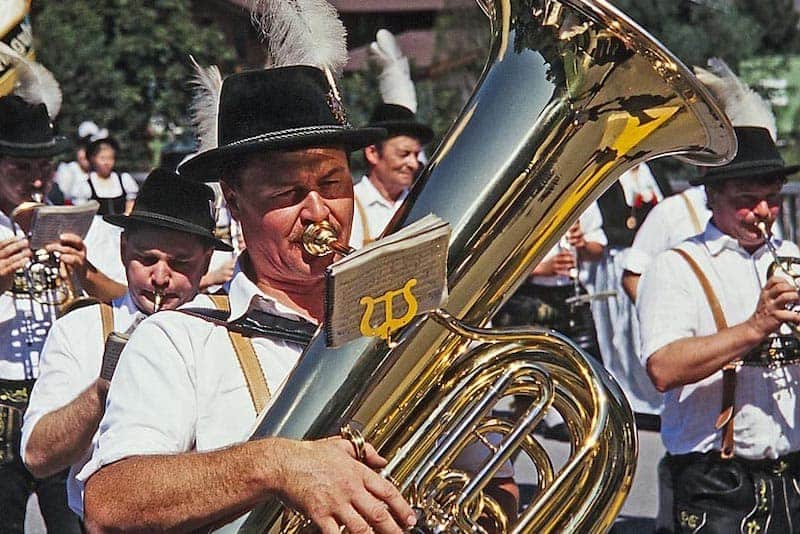
The lowest sounding instrument in the brass section is the tuba.
It is one of the youngest instruments in an orchestra first being used in the mid 19th century.
It’s quite large so is usually placed on the lap of the musician and uses valves to play notes of different pitch.
How many tubas are there in an orchestra?
An orchestra will usually only have one tuba.
Woodwind Section
Nowadays most of the instruments in the woodwind family are made out of metal or plastic but they used to all be made out of wood, hence the name woodwind.
Woodwind instruments are played by blowing air into the mouthpiece where it travels down a tube.
Players can change the pitch by playing keys which cover up different holes and depending on where the air escapes it produces different pitches.
The four main instruments in the woodwind section (in order of highest to lowest pitch) are:
- Flute
- Oboe
- Clarinet
- Bassoon
The Flute

The flute is the highest sounding of the standard orchestra woodwind instruments (although the piccolo is higher).
It’s played played by blowing air across a hole in the mouthpiece.
Because it’s higher in pitch, like the violin, it will often play the melody of a piece.
How many flutes in an orchestra?
There are usually four flutes in an orchestra (with one of them also playing piccolo).
The Oboe
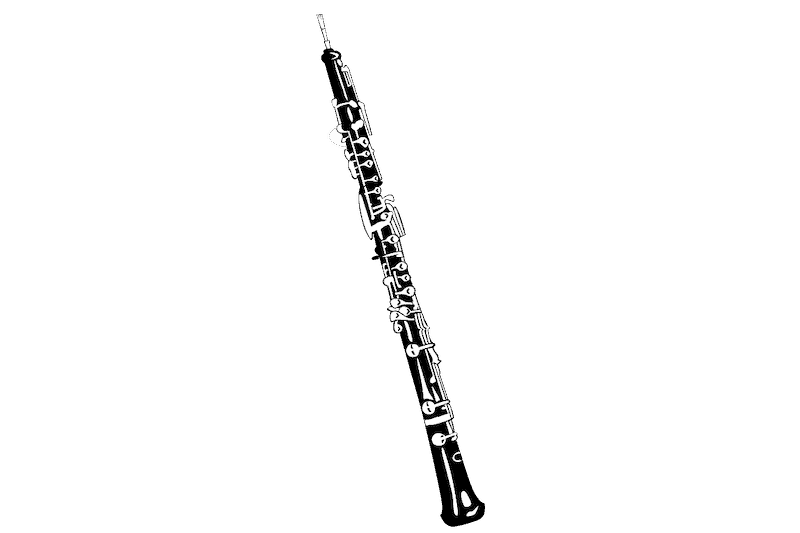
The oboe which is still made out of wood, is one of two double reed instruments in an orchestra (the other being the bassoon).
The musician blows between the two reeds which then causes them to vibrate and produces the sound.
Like the flute it is higher in pitch and so will usually carry the melody.
It’s got a slightly more mellow sound though and is less piercing than the flute.
The Clarinet
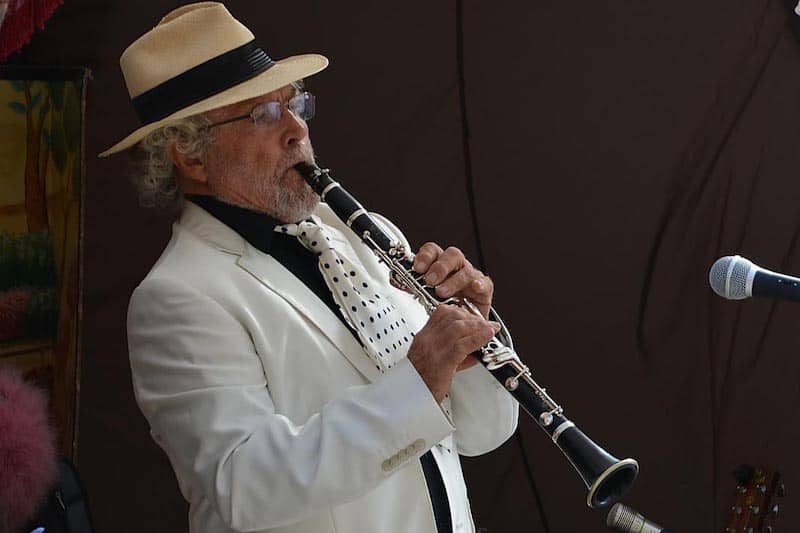
The clarinet is also made out of wood.
Unlike the oboe it’s a single reed instrument.
This means that musicians will blow between the reed and the mouthpiece which creates the reed to vibrate and make the sound.
How many clarinets are there in an orchestra?
There are usually four clarinets in an orchestra.
The Bassoon
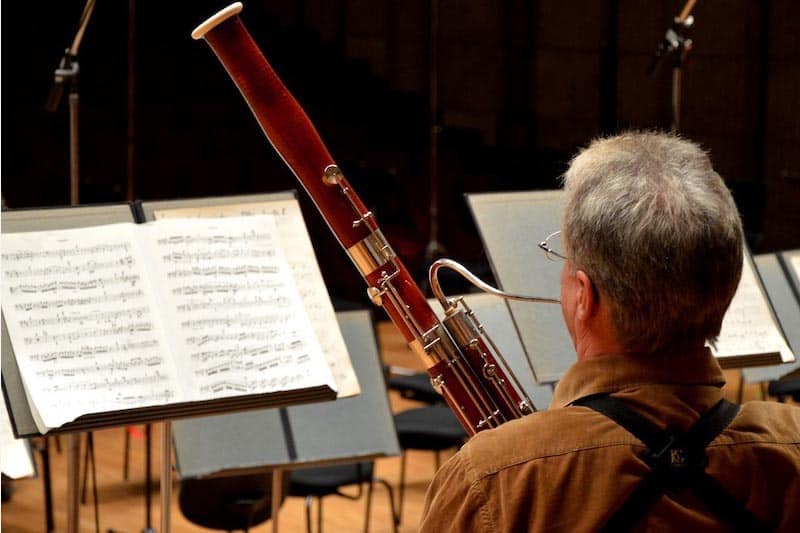
The larger cousin of the oboe, a bassoon is another type of double reed instrument.
It’s the lowest sounding standard orchestral instrument in the woodwind family but you can get a double bassoon which is lower.
How many bassoons are there in an orchestra?
There are usually four bassoons in an orchestra.
Percussion Section
Lastly, we’re going to take a look at the percussion family of instruments.
Percussion instruments are played by either hitting, shaking or scraping them to produce their sound.
There are two types of percussion instruments.
- Pitched
- Unpitched
This means that some of the percussion instruments can produce differently pitched notes whereas others make a sound without a definite pitch.
Definite Pitch Percussion Instruments
Definite pitch percussion instruments are those that produce a pitched note when they’re played.
Some, like the glockenspiel or marimba, can play lots of different pitches where as others, like the timpani, are tuned to one specific note.
They’re often played by using a mallet or stick to hit the instrument which produces the sound.
Pitched percussion instruments are generally used to create counter melodies and provide harmony to a piece.
Some pitched percussion instruments include:
- Timpani (kettle drums)
- Vibraphone
- Xylophone
- Marimba
- Glockenspiel
- Tubular bells (chimes)
- Celeste (celesta)
Let’s take a look at a few in more detail.
Timpani (kettle drums)
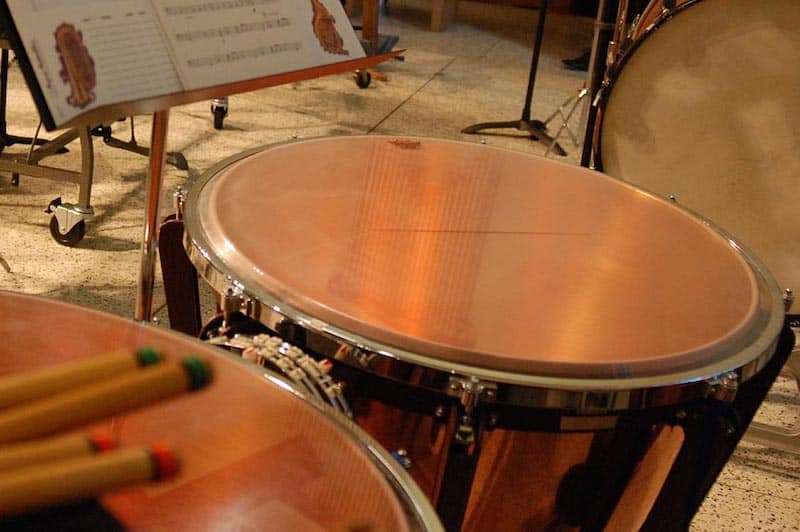
The timpani, which is also called a kettle drum, is a large copper bowl drum with drumheads made of plastic or calfskin.
Timpani can be tuned to specific notes by stretching or loosening the drumheads with a foot pedal.
It’s played by striking the top with a mallet or wooden drumstick to create the sound.
There tends to be at least four timpani in an orchestra each one tuned to a different note.
Vibraphone
The vibraphone (also known as vibes) is a keyboard style percussion instrument that is made up of tuned metal bars.
Vibraphonists play by striking the bars with a mallet which then produces the sound.
It also has a sustain pedal (like a piano) that can make the notes last longer.
Marimba
The marimba is very similar to a xylophone.
The difference between them is to do with their tuning: A marimba has soft tones whereas a Xylophone has hard tones.
The marimba is definitely one of my favourite sounding instruments!
Xylophone
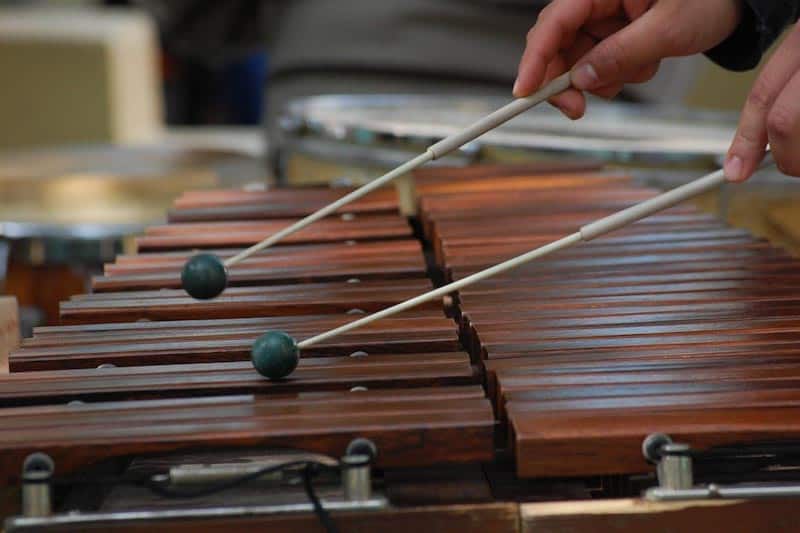
The xylophone is another keyboard percussion instrument that originally came from Asia and Africa.
It’s very similar to the marimba but it tends to be higher sounding in pitch and makes a harder, drier sound.
It also has wooden bars that are hit with sticks or mallets.
Glockenspiel
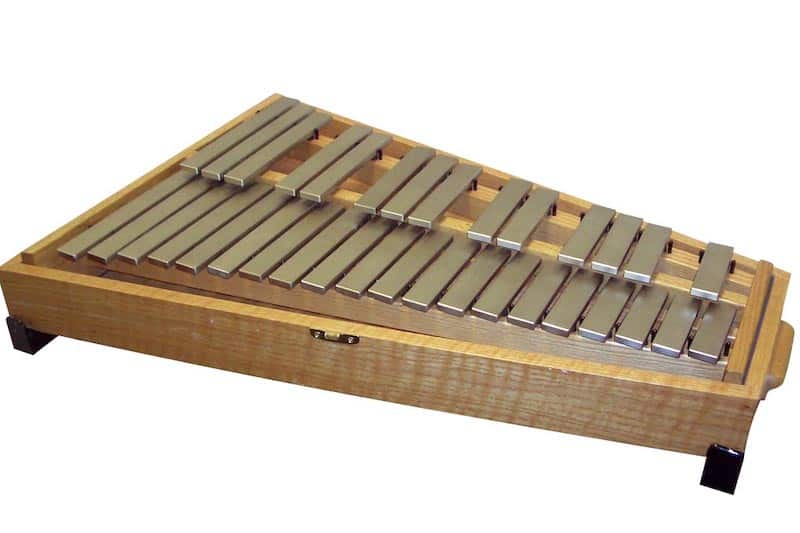
The glockenspiel (which in German means chimes), is another tuned percussion instrument that has a keyboard similar to a piano.
Like the marimba, xylophone and vibraphone, each bar is hit with a stick or mallet to produce the sound.
Glockenspiels are made out of metal and tend to be a lot smaller and higher pitched than the other keyboard style percussion instruments.
Tubular Bells
The tubular bells are a set of tuned pipes that are made to imitate the sound of church bells.
They’re played by using a wooden mallet which causes the pipes to ring.
Like the vibes they have a sustain pedal to make the notes last longer.
Other Definite Pitch Percussion Instruments
The instruments I’ve covered above are just a few of the pitched percussion instruments that exist.
There are lots of others like:
- The celeste
- The harp
- The piano
You might think that the piano is actually a string instrument since the sound is made by strings but, when you play the keys it actually causes a hammer to hit the string which is why it’s classed as a percussion instrument.
Indefinite Pitch Percussion Instruments
Indefinite pitch percussion instruments are those that don’t produce a definite pitched note.
They are used for playing rhythms where as pitched percussion will be used to play melodies and harmony.
They’re usually played by hitting them with a stick or mallet, scratching or shaking to produce their sounds.
Some common un-pitched percussion instruments include:
- Tambourine
- Snare drum
- Side drum
- Triangle
- Bass drum
- Cymbals
- Castanets
- Tam-tam
In a music theory exam you can use any of these if you’re asked to name a percussion instrument that doesn’t have a definite pitch.
Summing Up
Anyway, I hope that helps to make a bit more sense of some of the instruments in an orchestra.
I’ll be updating this post soon with some of the different ranges of the instruments, which clefs they read in and specific techniques that certain instruments use.
If you have any questions though just post a comment below!
